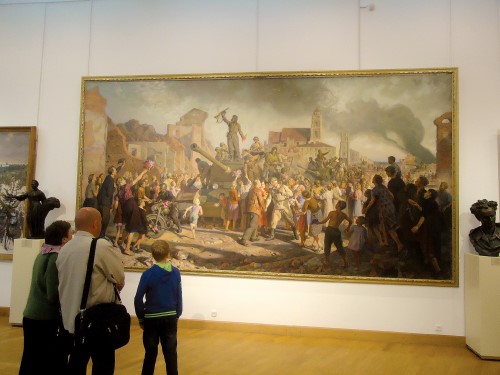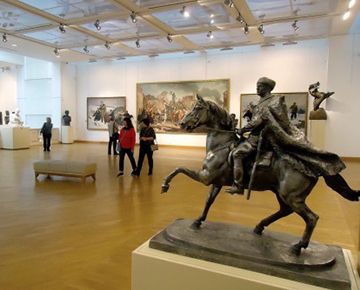
The pieces on show are from the museum’s own archive, and have been on show since April, devoted to the events of the Great Patriotic War and the Great Victory — achieved by our Soviet and Belarusian peoples.
On June 22nd, 1941, Belarus appeared at the epicentre of WWII. By late August, all its territory had been occupied by the Germans. In 1942, the central and Belarusian headquarters of the partisan movement were established at the Supreme High Command General Headquarters. Belarus became called a ‘partisan republic’. During the ‘rail war’ and Operation Bagration, of June-July 1944, the country was completed cleared of fascists.
The history of Belarusian art is closely connected with those military events. Some artists went to the frontline, while others were evacuated, or stayed within occupied territory, joining the partisan movement. The pre-war collection of the State Picture Gallery (upon which the National Art Museum was later founded) failed to be evacuated; as a result, most artefacts were stolen or destroyed during bombing and fires.

Despite terrible conditions, Belarusian artists never stopped work, resorting to small sketches, drafts, posters, portraits and caricatures. After Belarus’ liberation, they toured the sites of military action, portraying war heroes.
The war theme began flourishing in Belarusian art in the late 1940s-1960s, with many pieces currently on show dating from that time: paintings, graphic and sculptural pieces, and works of decorative-and-applied art, dedicated to Brest Fortress’ defence, Minsk’s liberation, and the partisans and USSR heroes who gave their lives. Among the latter are Uncle Minai (Minai Shmyrev), Nikolay Gastello, Lev Dovator, Alexey Danukalov, Konstantin Zaslonov, Piotr Kalinin, Piotr Kupriyanov, Yelena Mazanik, Mikhail Silnitsky and Grandfather Talash (Vasil Talash); these people and their deeds have inspired artists, composers, and theatrical and cinema directors.
The exhibition presents works by 22 People’s Artists of Belarus: Zair Azgur, Anatoly Anikeichik, Ivan Akhremchik, Andrey Bembel, Gavriil Vashchenko, Valentin Volkov, Alexey Glebov, Victor Gromyko, Alexander Grube, Lev Gumilevsky, Mai Dantsig, Yevgeny Zaitsev, Arlen Kashkurevich, Raisa Kudrevich, Pavel Maslenikov, Georgy Poplavsky, Mikhail Savitsky, Sergey Selikhanov, Vladimir Stelmashonok, Vitaly Tsvirko, Vasily Sharangovich and Leonid Shchemelev.

In addition, the show features works by Belarusian painters never before exhibited within the museum’s permanent displays: Leonid Osedovsky, Piotr Danelia, Abram Krol, Eduard Kufko, Sofia Li, Boris Nepomnyashchy, Valentin Savitsky, Boris Uss, Vladimir Khrustalev and Yevgeny Tikhonovich.
Their genres vary — including portraits, landscapes and thematic pictures — but all are united in their theme. For several decades, our artists have been creating allegorical and metaphorical compositions, which depict the tragic, intense atmosphere of those war years, dramatic and emotional. Among them are Leonid Osedovsky’s Mother’s Ballad, Vitaly Tsvirko’s Unbroken, Yevgeny Zaitsev’s Standing to the Death, Olgerd Malishevsky’s We Shall Return, Natan Voronov’s Cherishing Memories of Comrades-in-Arms, Nikolay Zalozny’s Poppies, Israel Basov’s Recollection, Mikhail Savitsky’s Vitebsk Gates and Partisan Madonna, Victor Gromyko’s 1941: Over Pripyat, Leonid Shchemelev’s My Birth, Gavriil Vashchenko’s Breakthrough, Ivan Rei’s Thank You, Mother, and Vasily Sumarev’s Song of Partisans.
These and other works devoted to that terrible war are a true requiem to fearlessness and self-sacrifice, heroism and tragedy. The show will leave no one unmoved.
By Veniamin Mikheev











